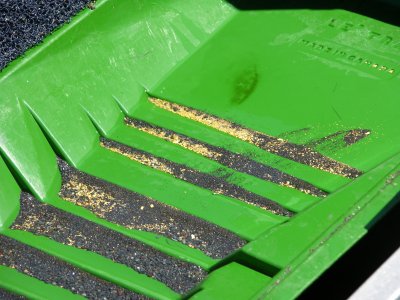BY SAMUEL T. LONG
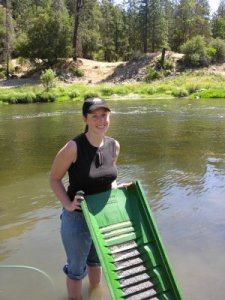 No matter what the size or nature of our mining operations, we all have one common procedure to deal with—the cleaning up of our concentrates. Sometimes, the process of separating the gold from the other sand and gravel is a tedious task. But, there is a way to make it relatively quick and easy.
No matter what the size or nature of our mining operations, we all have one common procedure to deal with—the cleaning up of our concentrates. Sometimes, the process of separating the gold from the other sand and gravel is a tedious task. But, there is a way to make it relatively quick and easy.
This final step, before the gold is totally isolated, is of no less importance than the prior steps used to recover the gold laden concentrates themselves. Many times, in a mining operation, much thought and energy have been used to successfully reach the clean-up stage, only to squander the last remaining hours of the afternoon or early evening on an inappropriate and/or wasteful system of final gold clean-up. In fact, some operations take so long to complete this stage that they’re not started until the next day!
Final clean-up of concentrates should take minutes, not hours. If you can’t go from sluice box concentrates to gold in a bottle in less than an hour, your technique needs to be examined, then streamlined.
We all know the direct relationship between time, effectiveness, and gold. Its no secret, for instance in dredging, that the more time you spend during the day pumping gravel, the more gold you’ll have at the end of the day. All the effort you spend on plug-ups, throwing and re-throwing rocks, moving the dredge, winching unnecessary boulders, and all the other odds and ends “Murphy” continually throws at you, essentially steals valuable time from operating the suction nozzle. This, in turn, logically lessens the amount of gold in your box on any given day. So, an important aspect of successful gold production is efficiency. Isolated efficiency used mainly during diving time is not enough. Productivity, in every aspect of your over-all mining operation, is vital for success. Clean-up of concentrates is no exception.
Before we go any further, lets look at a few clean-up methods that, for one reason or another, don’t prove to be satisfactory. Maybe yours is in this short list:
1. Panning: Simple, direct, and economical. But time consuming. It works after a fashion, but obviously a prospector’s sampling tool, at best. If you do use a pan to do final clean-up, you will find the process goes much better if you first classify your concentrates through a series of mesh-screens and pan each size-fraction separately.
2. The Tweezer Method: Again—simple, direct, economical and EXTREMELY time consuming. Actually, it works great for the first eight or ten pieces of gold you pick up. Its the next two hundred pieces, or 20,000 pieces, and your unasked for double vision, that puts the “kibosh” to this method. This method is unworkable as soon as you begin finding more than just gold traces in your sampling.
3. Spiral Gold Wheels: Here’s the backbone of many clean-up operations. Wheels are basically good tools at a moderate price, but can fall flat on their face when it comes to efficient use of time. Its almost impossible to classify, run, and re-run concentrates through any wheel and still break the one hour target. If you use a wheel, don’t throw away the final concentrates that remain in the bottom-edge of the wheel after all the gold has climbed out. Because there always seem to be pieces of gold that will not climb out! Save those concentrates for another day…
4. Shaker Tables: Very effective for fixed commercial operations. But generally too bulky to support portable sampling programs. They are also quite expensive. Unless you already own one, you can still be effective without it.
This is not to say that there is only one correct way to clean-up; and if you’re not doing it that way, that you’re doing it wrong. This is just to show you a fairly quick, cost-effective, simple way to separate gold from your sluice box concentrates; a method by which you can cut your clean-up time from two hours to less than one hour with only the addition of a few simple tools and techniques:
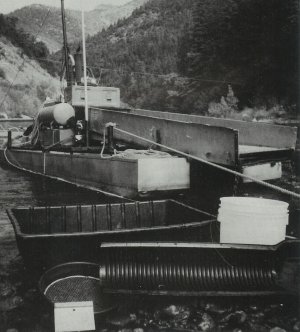
1. A very important part of any efficient clean-up method is what percentage of the sluice that you are cleaning up. No matter what size sluice you have, or how it came from the factory, it is imperative that you re-design it so it’s possible to clean the top 20-25% of it without disturbing the rest of the sluice.
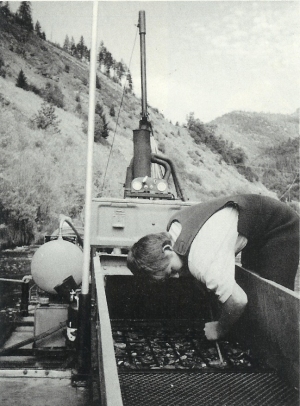
We call this the “high-grader.” Because it is extremely heavy, eighty percent or more of the gold will regularly be in the top 20% of the sluice box. Given this fact, there’s no need to spend extra time and effort cleaning the entire box each time you clean-up. All that extra time could be much-more effectively invested in the sampling or production-phases of your program! On an average, clean the top section every day, the middle section every two weeks and the back section every month or so. You have to be flexible about this, depending upon how rich the gravel is that you are mining. This saves a lot of work while still retaining all the gold. Design your sluice in individual sections and clean them on a staggered basis.
2. Remove the riffles and miners moss with concentrates from the top section. Rinse the riffles and thoroughly wash out the miners moss into a utility tub. A flat kitchen-counter scraper works well to clean the bottom of the sluice. Immediately replace the miners moss and riffles.
3. Using another utility tub, transfer the concentrates from one to another via a 4-mesh classifying screen.
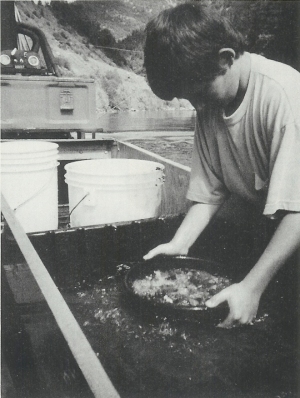
Check the top of the screen for nuggets before discarding the over-sized material. You never know when one will appear. This 4-mesh classification should cut the amount of concentrates by around fifty percent. Dump the classified material into a five gallon bucket. Now you have gone from five gallons of concentrates to two in only about ten minutes.
4. Start the dredge and run it at low idle. Set the black plastic mini sluice (or the Le’ Trap plastic clean-up sluice) in the top of the sluice. The moving water will hold it in place. Note here that it is counter productive to use a longer plastic sluice instead of a small one. That’s because you’ll end up with twice as much material, but no more gold. The object of this step is to get the material down to a workable amount for final clean-up. If you use too large a mini sluice, it will take another step to reach this proper volume. While it is probably not necessary, we like to lace the one-foot square of miners moss under the tail of the mini sluice in such a manner that all material washing out must travel over the moss. This is to catch any fine flakes of gold that may be washed out of the sluice. However, because the process is usually done inside the sluice box of your bigger recovery system, there is little chance any gold can be lost anyway.
5. Carefully drop the concentrates a handful at a time into the top of the mini sluice.
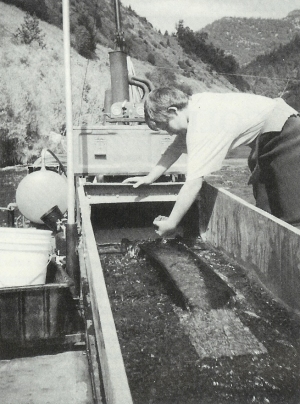
Adjust the water flow via the throttle so that the concentrates are gently carried away while leaving the gold in the top few riffles. We have found that this step goes much quicker and simpler than using a gold wheel or gold pan. The process is so efficient, we have found that running the concentrates through the mini-sluice twice is a waste of time.
6. At this point you’ve only spent about twenty minutes and you’re more than half-way to having completely separated the gold from the rest of the concentrates. Next, rinse out the square of miners moss and the contents of the mini sluice into a bucket.
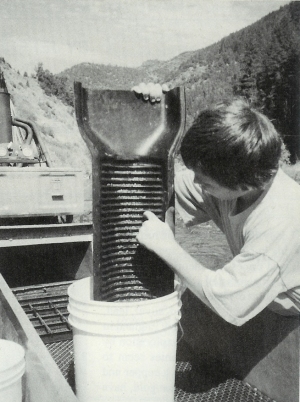
Notice there is only a fraction of a pan’s worth of concentrates remaining. These can be dried out in a small, steal gold pan over an open flame (outside in a well-ventilated area), screened, and carefully separated with a gentle blowing process on paper. The best demonstration I have ever seen of this final process of separation can be found in Dave McCracken’s video, “Successful Gold Dredging Made Easy.” Who said clean-up had to be tedious and time-consuming using expensive tools? So far, we haven’t even left the river and we’ve gone from nearly five gallons of concentrates to less than a cup in only twenty-to-thirty minutes. This easy technique, coupled with the dry final separation, is all you need to make your operation more enjoyable and successful.
Expertise in clean-up demands an approach that will deliver all of the gold in your concentrates in less than an hour. Anything longer than this is a waste of time and energy which definitely subtracts from your over-all mining success and enjoyment. As you know, a chain is only as strong as its weakest link. While streamlining clean-up may not drastically improve total gold quantity, it is surely a step in the right direction. Gained insight concerning your clean-up methods may reveal ineffectiveness in other areas as well; the sum of which very well could mean the distinct difference between success and failure in your operation.


